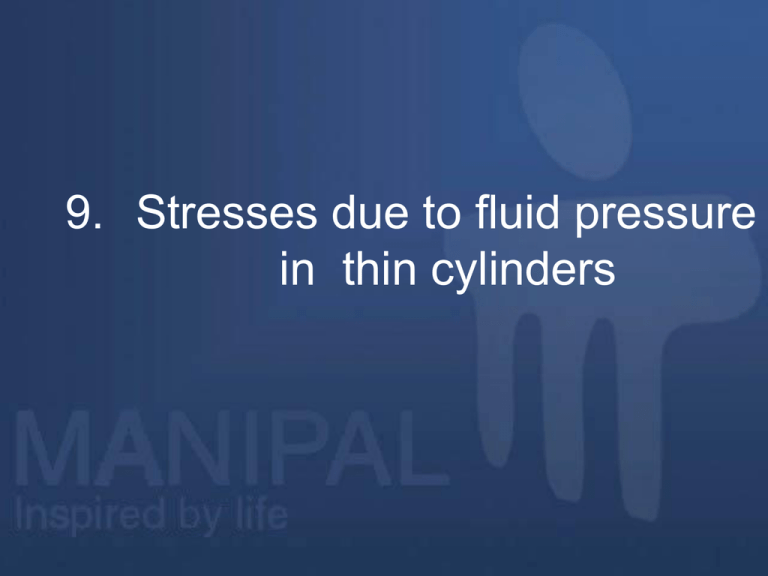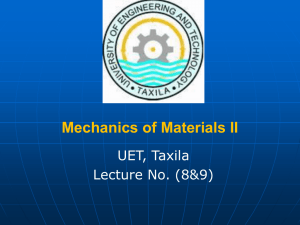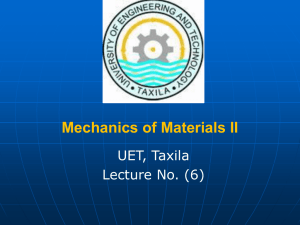thin cylinders - EngineeringDuniya.com
advertisement

9. Stresses due to fluid pressure in thin cylinders 9 -THIN CYLINDERS INTRODUCTION: In many engineering applications, cylinders are frequently used for transporting or storing of liquids, gases or fluids. Eg: Pipes, Boilers, storage tanks etc. These cylinders are subjected to fluid pressures. When a cylinder is subjected to internal pressure, at any point on the cylinder wall, three types of stresses are induced on three mutually perpendicular planes. They are, 1. Hoop or Circumferential Stress (σC) – This is directed along the tangent to the circumference and tensile in nature. Thus, there will be increase in diameter. 2. Longitudinal Stress (σL) – This stress is directed along the length of the cylinder. This is also tensile in nature and tends to increase the length. 3. Radial pressure (σ r) – It is compressive in nature. Its magnitude is equal to fluid pressure on the inside wall and zero on the outer wall if it is open to atmosphere. σC σC p σC σL σL p σC 1. Hoop /Circumferential Stress (σC) σr p σL σL 2. Longitudinal Stress (σL) Element on the cylinder wall subjected to these three stresses σr 3. Radial Stress (σr) σC σL σL σC σr A cylinder or spherical shell is considered to be thin when the metal thickness is small compared to internal diameter. i. e., when the wall thickness, ‘t’ is equal to or less than ‘d/20’, where ‘d’ is the internal diameter of the cylinder or shell, we consider the cylinder or shell to be thin, otherwise thick. Magnitude of radial pressure is very small compared to other two stresses in case of thin cylinders and hence neglected. pd Circumfere ntial stress,σ C 2 t pd Longitudinal stress, σ L 4 t Maximum Shear stress, max = (c- L) / 2 max = ( p x d) / (8 x t) Where p = internal fluid pressure d= internal diameter, t = thickness of the wall EVALUATION OF STRAINS σ L=(pd)/(4t) σ C=(pd)/(2t) σ C=(pd)/(2t) σ L=(pd)/(4t) A point on the surface of thin cylinder is subjected to biaxial stress system, (Hoop stress and Longitudinal stress) mutually perpendicular to each other, as shown in the figure. The strains due to these stresses i.e., circumferential and longitudinal are obtained by applying Hooke’s law and Poisson’s theory for elastic materials. Circumfere ntial strain, ε C : σC σL σL σL εC μ 2 μ C=(pd)/(2t) E E E E σL (2 μ) E δd pd i.e., ε C (2 μ) d 4 t E L=(pd)/(4t) C=(pd)/(2t) L=(pd)/(4t) Longitudin al strain, ε L : σC σL σL (2 σ L ) σ L εL μ μ (1 2 μ) E E E E E i.e., δl pd εL (1 2 μ) L 4 t E dv VOLUMETRIC STRAIN, V σL=(pd)/(4t) π 2 σC=(pd)/(2t) σC=(pd)/(2t) We have volume, V d L. 4 π 2 π dV d dL L 2 d dd σL=(pd)/(4t) 4 4 π 2 π d dL L 2 d dd dv 4 dL dd 4 2 π 2 V L d d L 4 pd pd dV (1 2 μ) 2 (2 μ) = ε +2× εC V L 4 t E 4 t E i.e., dv pd (5 4 μ) V 4 t E Illustrative Problems Q.9.1 A thin cylindrical shell is 3m long and 1m in internal diameter. It is subjected to internal pressure of 1.2 MPa. If the thickness of the sheet is 12mm, find the circumferential stress, longitudinal stress, changes in diameter, length and volume . Take E=200 GPa and μ= 0.3. SOLUTION: 1. Circumferential stress, σC: σC= (p×d) / (2×t) = (1.2×1000) / (2× 12) = 50 MPa (Tensile). 2. Longitudinal stress, σL: σL = (p×d) / (4×t) = σ C/2 = 50/2 = 25 MPa (Tensile). 3. Circumferential strain, εc: (p d) (2 μ) (1.2 1000) (2 0.3) (4 t) E (4 12) 200 103 25 (2 0.3) -04 2.125 10 (Increase) 3 (200 10 ) εc Change in diameter, δl = εc ×d = 2.125×10-04×1000 = 0.2125 mm (Increase). 4. Longitudinal strain, εL: (p d) (1 2 μ) (1.2 1000) (1 2 0.3) (2 t) E (2 12) 200 103 50 (1 2 0.3) -05 5 10 (Increase) 3 (200 10 ) εL Change in length = ε L ×L= 5×10-05×3000 = 0.15 mm (Increase). Volumetric strain, dv : V dv (p d) (1.2 1000) (5 4 μ) (5 4 0.3) 3 V (4 t) E (4 12) 200 10 4.75 10-4 (Increase) π Change in volume, dv 4.75 10 V 4.75 10 1000 2 3000 4 1.11919 106 mm 3 1.11919 10-3 m3 1.11919 Litres . -4 -4 Q.9.2 A cylindrical boiler is 800mm in diameter and 1m length. It is required to withstand a pressure of 100m of water. If the permissible tensile stress is 20N/mm2, permissible shear stress is 8N/mm2 and permissible change in diameter is 0.2mm, find the minimum thickness of the metal required. Take E = 89.5GPa, and μ = 0.3. SOLUTION: Fluid pressure, p = 100m of water = 100×9.81×103 N/m2 = 0.981N/mm2 . 1. Thickness from Hoop Stress consideration: (Hoop stress is critical than long. Stress) σC = (p×d)/(2×t) i. e., 20 = (0.981×800)/(2×t) Therefore, t = 19.62 mm 2. Thickness from Shear Stress consideration: τ max (p d) (0.981 800) i.e., 8 (8 t) (8 t) t 12.26mm. 3. Thickness from permissible change in diameter consideration (δd=0.2mm): Therefore, required thickness, t = 19.62 mm. Q.9.3 A cylindrical boiler has 450mm in internal diameter, 12mm thick and 0.9m long. It is initially filled with water at atmospheric pressure. Determine the pressure at which an additional water of 0.187 liters may be pumped into the cylinder by considering water to be incompressible. Take E = 200 GPa, and μ = 0.3. SOLUTION: Additional volume of water, δV = 0.187 liters = 0.187×10-3 m3 = 187×103 mm3 π 450 2 (0.9 1000) 143.14 106 mm 3 4 dV pd p 450 (5 4 μ) (5 4 0.33) 3 V 4 t E 4 12 200 10 187 103 Solving, p=7.33 N/mm2 6 143.14 10 V JOINT EFFICIENCY The cylindrical shells like boilers are having two types of joints namely Longitudinal and Circumferential joints. Due to the holes for rivets, the net area of cross section decreases and hence the stresses increase. If the efficiencies of these joints are known, the stresses can be calculated as follows. Let ηL=Efficiency of Longitudinal joint and ηC=Efficiency of Circumferential joint. Circumferential stress is given by, pd σC 2 t ηL .............(1) Longitudinal stress is given by, pd σL .............(2) 4 t ηC Note: In longitudinal joint, the circumferential stress is developed and in circumferential joint, longitudinal stress is developed. Q.9.4 A cylindrical tank of 750mm internal diameter, 12mm thickness and 1.5m length is completely filled with an oil of specific weight 7.85 kN/m3 at atmospheric pressure. If the efficiency of longitudinal joints is 75% and that of circumferential joints is 45%, find the pressure head of oil in the tank. Take permissible tensile stress of tank plate as 120 MPa and E = 200 GPa, and μ = 0.3. SOLUTION: Let p = max permissible pressure in the tank. Then we have, σL= (p×d)/(4×t) ≤ ηC×120 = (p×750)/(4×12) ≤ 0.45×120 p = 3.456 MPa. Also, σC= (p×d)/(2×t) ≤ ηL×120 = (p×750)/(2×12) ≤ 0.75×120 p = 2.88 MPa. Max permissible pressure in the tank, p = 2.88 MPa. Vol. Strain, dv (p d) (5 4 μ) V (4 t E) (2.88 750) -4 (5 4 0.3) 8.55 10 (4 12 200 103 ) π -4 -4 dv 8.55 10 V 8.55 10 750 2 1500 0.567 106 mm 3 . 4 0.567 10-3 m 3 0.567 litres. Q.9.5 A boiler shell is to be made of 15mm thick plate having a limiting tensile stress of 120 N/mm2. If the efficiencies of the longitudinal and circumferential joints are 70% and 30% respectively determine; i) The maximum permissible diameter of the shell for an internal pressure of 2 N/mm2. (ii) Permissible intensity of internal pressure when the shell diameter is 1.5m. SOLUTION: (i) To find the maximum permissible diameter of the shell for an internal pressure of 2 N/mm2: a) Let limiting tensile stress = Circumferential stress = σc = 120N/mm2. i. e., pd σc 2 ηL t 2 d 120 2 0.7 15 d 1260mm. b) Let limiting tensile stress = Longitudinal stress = σL = 120N/mm2. i. e., pd σL 4 ηC t 2 d 120 4 0.3 15 d 1080mm. The maximum diameter of the cylinder in order to satisfy both the conditions = 1080 mm. (ii) To find the permissible pressure for an internal diameter of 1.5m: (d=1.5m=1500mm) a) Let limiting tensile stress = Circumferential stress = σc = 120N/mm2. i. e., σc pd 2 ηL t 120 p 1500 2 0.7 15 p 1.68 N/mm 2 . b) Let limiting tensile stress = Longitudinal stress =σL = 120N/mm2. i. e., pd σL 4 ηC t p 1500 120 4 0.3 15 p 1.44 N/mm 2 . The maximum permissible pressure = 1.44 N/mm2. Exercise Problems Q1. Calculate the circumferential and longitudinal strains for a boiler of 1000mm diameter when it is subjected to an internal pressure of 1MPa. The wall thickness is such that the safe maximum tensile stress in the boiler material is 35 MPa. Take E=200GPa and μ= 0.25. (Ans: ε C=0.0001531, ε L=0.00004375) Q2. A water main 1m in diameter contains water at a pressure head of 120m. Find the thickness of the metal if the working stress in the pipe metal is 30 MPa. Take unit weight of water = 10 kN/m3. (Ans: t=20mm) Q3. A gravity main 2m in diameter and 15mm in thickness. It is subjected to an internal fluid pressure of 1.5 MPa. Calculate the hoop and longitudinal stresses induced in the pipe material. If a factor of safety 4 was used in the design, what is the ultimate tensile stress in the pipe material? (Ans: σC=100 MPa, σL=50 MPa, σU=400 MPa) Q4. At a point in a thin cylinder subjected to internal fluid pressure, the value of hoop strain is 600×10-4 (tensile). Compute hoop and longitudinal stresses. How much is the percentage change in the volume of the cylinder? Take E=200GPa and μ= 0.2857. (Ans: σC=140 MPa, σL=70 MPa, %age change=0.135%.) Q5. A cylindrical tank of 750mm internal diameter and 1.5m long is to be filled with an oil of specific weight 7.85 kN/m3 under a pressure head of 365 m. If the longitudinal joint efficiency is 75% and circumferential joint efficiency is 40%, find the thickness of the tank required. Also calculate the error of calculation in the quantity of oil in the tank if the volumetric strain of the tank is neglected. Take permissible tensile stress as 120 MPa, E=200GPa and μ= 0.3 for the tank material. (Ans: t=12 mm, error=0.085)








